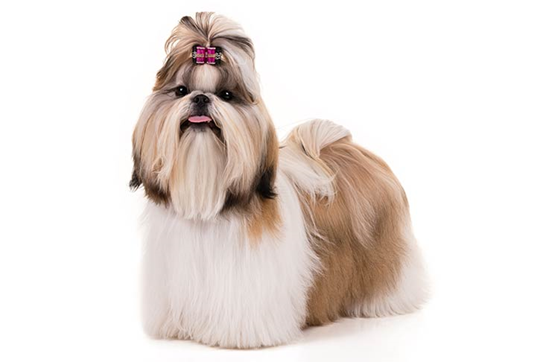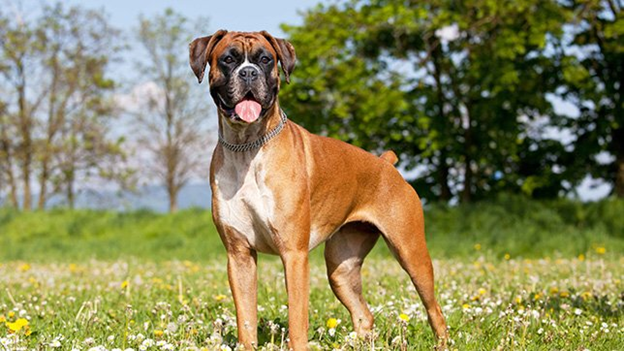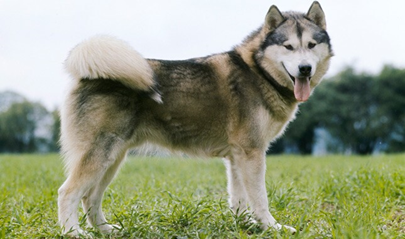Breed Related Diseases: Shi Tzu

The Shi Tzu is a small dog- Toy Breed, known for its personality: lively and outgoing. Their traits of being sweet, playful, friendly, intelligent, and its appearance could win you over. However, this dog has the tendency to be aggressive, fearful, bark excessively, and difficult to train. Despite the expected characteristics of Shi Tzu, like all other breeds, temperament will vary. Known to have originated in China, the name Shi Tzu means “lion dog”, resembling lion as depicted in traditional oriental art. Generally, this dog lives in a long life span of 10 to 16 years, with an average height of 27 cm and average weight of 4.5-7.5 kg. Their coat comes in many colors, and the silky, long hair will need regular grooming. They may be sensitive to heat and need only moderate exercise, but they enjoy being with their family and they need attention. The small size makes it fragile and prone to injuries. Health problems of Shi Tzu exist, and it is important to have regular health check- ups with your vet. Skin Conditions and Allergies- Shi Tzu is sensitive to allergens. They may present itchiness, skin irritations and dermatitis when developed allergies. Skin Allergy is referred as “atopy”. It most commonly affects their feet, belly, folds of the skin, and ears. They could also be seen having hair loss. However, symptoms of allergies can also be caused by other skin conditions. Specific diets, regular preventives, and/ or medicated shampoos can be used to manage some allergies. It is important to prevent possible causes of allergies, however, dogs react differently to environments. Ear Infections- Also known as otitis externa. With floppy ears, Shi Tzu are susceptible to ear infections. You may notice your dog scratching at the ears and shaking their head. Presented signs also include redness of the inner ear, a dark discharge, a bad odor or general pain in their ear area. Ear infections can be triggered by allergies and too much moisture in the ear canal, or may be a result of other underlying diseases. Regular cleaning of your dog’s ear can help preventing ear infections. Breathing Problems- Due to their short, flat faces, Shih Tzus are susceptible to respiratory and breathing problems. They have narrow upper airways and small and delicate tracheas, making it hard for them to breathe. You may notice your dog having shallow and difficulty in breathing, excessive panting, trouble eating, snoring, and coughing. In extreme cases, collapsing and passing out are possible. Over-exercising should be avoided, and walking them in either early morning or late evening with cooler air is recommended. Brachycephalic Obstructive Airway Syndrome (BOAS) is a respiratory issue which can cause problems in regulating their body temperature. This can also lead to secondary issues caused by increased demands on their heart and lungs. Eye Problems- Their large, dark eyes make them particularly prone to eye problems. They can inherit or develop eye conditions and are more susceptible to eye injuries due to the naturally protruding eyeballs. Most common injuries are resulting from corneal scrapes and punctures. Hip Dysplasia- It is a condition of abnormally developed hip joints with different severities. This is common and painful genetic problem. It is important to see the dog’s hip health to avoid being bred. Hypothyroidism- It is a hormonal disease affecting their thyroid gland, resulting to lack of thyroxine, which controls metabolism. This disease may cause hair loss, dull and thin coat, blackened areas of skin, lethargy, less keen to exercise and weight gain. Hyperadrenocorticism (Cushing’s )- Although this condition may develop slowly, it is common to Shi Tzu. This disease is a result of malfunctioning adrenal glands, with excessive production of Adrenocorticotropic Hormone (ACTH), affecting their metabolism and inflammatory and immune responses. Symptoms displayed include frequent drinking and urinating, increased appetite and reduced activity level, potbelly, thin skin, and hair loss. References: Shih Tzu The Shih Tzu is a small dog – one of the Toy breeds. He is generally described as lively and outgoing and despite his size requires plenty of exercise. He makes a delightful companion and family dog but as with all breeds temperament will vary. His coat will become very long unless trimmed and will … Continue readingShih Tzu Dog Breed Health
Breed- Related Diseases: Boxer

The Boxer breed was originally used to hunt large game and in fighting or baiting. However, the Boxers today are more refined and elegant than their ancestors, but they are still strong, smart, and fearless. This breed has smooth coat. With its medium size, it has square build and strong bone, with stretched muscles and strongly developed and molded appearance. The Boxers are a friendly and high-spirited breed, who are patient and gentle with children. They are fun, can play willingly, and are of high-energy dogs. They enjoy close human contact and is known as one of most popular dogs in America. However, this dog can be rowdy, gassy and drool a lot, attention- seeker which may exhibit signs of separation anxiety if left alone too much, and could be suspicious of strangers. On the other hand, like other dog breeds, Boxers can suffer from several health issues. Some of them can be treated if diagnosed early enough, and thus visiting your veterinarian to perform yearly tests and talk over health issues of your companion is important. Cancer– It is the most common health issue with this breed. It can be brain, thyroid, mammary glands, testes, heart, spleen, blood, lymph system (lymphoma), and other organs. Catching this early greatly increases the odds of survival, thus owners should keep an eye out for early symptoms. White Boxers, and colored Boxers with white markings are vulnerable to develop skin cancer from sunburns. Cardiomyopathy– This condition affects the heart muscle tissue which may result in episodes of weakness, fainting and sudden cardiac death, while some patients can develop congestive heart failure. This shows an irregular heartbeat. Aortic stenosis– A condition wherein there is a narrowing of the valve through which blood leaves the heart, usually caused by a fibrous ring of tissue. This may lead to progressive damage to the chamber that pumps the blood out of the heart, making the organ work harder to do its job. Regular health checks can help your vet detect the presence of this condition. A veterinary cardiologist can typically diagnose this condition after a heart murmur has been detected. Breeding dogs with this condition should be avoided. Bone and Joint Problems– These include hip dysplasia, cranial cruciate ligament ruptures (in the knee joints) and degenerative myelopathy (a progressive disease affecting the spine). Each condition can be diagnosed and treated to prevent undue pain and suffering. In the preventive healthcare of musculoskeletal disorders, keeping the right weight, providing high-quality diet, and avoiding and avoid excessive work on the knees (like playing Frisbee) are key in avoiding this painful injury. Also, joint supplements can be provided. Gastric Dilatation Volvulus (GDV) or Bloat or Torsion– This life- threatening condition occurs when air, fluid, food or foam collects in the stomach and making it expand, with or without twisting of the stomach. Whereas, stomach twisting can trap contents which leads to restricted blood flow to organs such as heart and stomach. Bloat may be suspected if your Boxer started to show swollen upper abdomen, signs of anxiety or agitation, retching but unable to vomit, excessive drooling or panting, and may be restless, depressed, lethargic, and weak with a rapid heart rate. Degenerative Myelopathy (DM)– It is a neurological disease reported in Boxers after middle age, and despite being not common, the Boxer is among the top 3 breeds to develop this. It affects the spinal column and nerves that coordinate the movement of the rear legs. This leads to paralysis, then progresses to front legs. Affected Boxers eventually lose their ability to walk, incontinent and are euthanized. This is a progressive, incurable disease of the spinal cord. Despite not being painful, it is quite serious. Allergies– Watch out for itchy, scaly skin, the breed Boxers are prone to allergies, both environmental allergies and food-related allergies. It is important to provide a proper diet and exercise routine to your Boxer. Keeping an appropriate weight is the easiest way to improve his health and extend his life. Building a routine care will help your Boxer live longer, stay healthier, and be happier during her lifetime. Any abnormal symptom could be a sign of serious disease, know when to seek veterinary help, and how urgently. References: https://animalhealthcenternh.com/client-resources/breed-info/boxer/ http://www.vetstreet.com/dogs/boxer#health https://www.animalfriends.co.uk/dog/dog-advice/dog-breed-health-problems/boxer-health-problems/ https://www.usboxer.org/health-issues http://www.allboxerinfo.com/boxer-dog-health-problems https://pavg.net/news/common-diseases-in-boxers/
Breed- Related Diseases: Alaskan Malamute

Standing at 23 to 25 inches at the shoulder, with weights of 75 to 85 pounds, Alaskan Malamutes are immensely strong, heavy-duty worker of spitz type. Originally bred to pull sleds in harsh terrain and brutal climates, these very solid dogs are however popular due to their looks and individual personalities. Often mistaken for Huskies, the Malamutes are larger and known for being affectionate, loyal, and playful. They are recognizable by th e well-furred plumed tail carried over the back, erect ears, and substantial bone. With the fact that the Alaskan Malamute is a big, powerful dog, they are also expert diggers and climbers- which makes keeping them behind the fence extremely difficult. Keeping them in the backyard isn’t a great idea unless you like holes the size of a swimming pool, and your neighbors like howling. It will not be a surprise to not find your malamute when you get home, since he considers fences to be interesting challenges rather than genuine obstacles. However, the destructiveness of your Malamute can be prevented with lots of exercises. Taking them to hiking, pulling sleds in winter and carts in summer, competitive weight pulling and formal obedience are can be good for his brain and his brawn. The Malamutes are also smart and curious. Mals don’t bark a lot, but they are very vocal and has the tendency to howl. They love to run, pull, and roam. Despite being sociable towards people, it can be aggressive toward strange dogs or animals. Training from a young age is recommended. Despite being relatively healthy breed with an average lifespan of 12 years, they can suffer from some common conditions like hip dysplasia, hypothyroidism, and bloat. This breed is also susceptible to bacterial and viral infections, such as parvo, rabies, and distemper, but many of these infections are preventable through vaccination. Relative to their breed, Malamutes can develop some health conditions to include: Hip dysplasia – A condition where hip joint doesn’t fit together perfectly, which will eventually lead to arthritis. This is a particularly devastating condition for an active running dog like the Malamute; and it requires costly surgery to correct. Before breeding, dogs should be screened by x-rays through the BVA/Kennel Club Hip Dysplasia Scheme. Hypothyroidism – This is due to an underactive thyroid, causing problems with weight, skin and energy levels. Chondrodysplasia – This is a form of dwarfism where cartilage and bone develop incorrectly. The puppies can be screened by x-ray between 5-12 weeks of age. Idiopathic polyneuropathy – This genetic disorder affects the dog’s nerves which causes chronic lack of coordination and weakness in the dogs. Before breeding, dogs should be screened by blood test to make sure they are not carriers. Day blindness (also known as haemeralopia or cone degeneration) – This is the sensitivity to bright light which affects their vision. Before breeding, dogs should be screened by blood test to make sure they are not carriers. Cataracts – These are a common cause of blindness in older Malamutes. There is a ‘clouding’ of the lens of the eye affecting vision. Surgery may be an option to remove cataracts and restore sight. Breeding dogs should be screened every year. Bloat– The Gastric Dilatation and Volvulus, also known as GDV or Bloat, usually occurs in dogs with deep, narrow chests, making Malamutes more at risk than other breeds. This condition results to stomach twisting- which cuts off blood supply to the stomach, and sometimes the spleen; and thus a quickly fatal disease, sometimes in as little as 30 minutes, if left untreated. Retching or heaving, acting restlessly, laying with front feet down, rear end up, and having enlarged abdomen can be observed. Take your pet to an emergency hospital immediately once symptoms are noticed. As a puppy, remember to socialize your Mal with lots of other dogs, different people and types of experiences. Taking your Mal, whether a puppy or adult, to a veterinarian soon after adoption is highly recommended to spot visible problems, and also to set up a preventive regimen that will help you avoid many health issues. References: https://www.pdsa.org.uk/pet-help-and-advice/looking-after-your-pet/puppies-dogs/large-dogs/alaskan-malamute https://www.yourpurebredpuppy.com/health/alaskanmalamutes.html https://animalhealthcenternh.com/client-resources/breed-info/alaskan-malamute/ https://www.akc.org/dog-breeds/alaskan-malamute/ https://vcahospitals.com/know-your-pet/dog-breeds/alaskan-malamute https://www.embracepetinsurance.com/dog-breeds/alaskan-malamute



